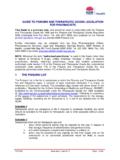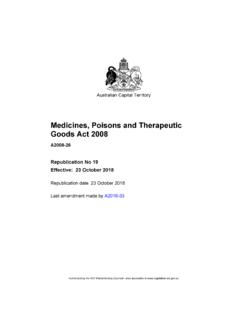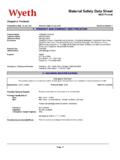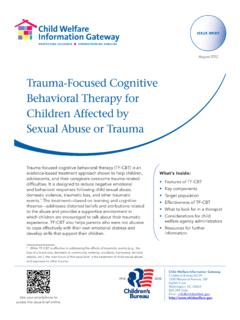Transcription of Guideline on similar biological medicinal products ...
1 7 Westferry Circus Canary Wharf London E14 4HB United KingdomTelephone+44 (0)20 7418 8400 Facsimile +44 (0)20 7418 agency of the European Union European Medicines Agency, 2012. Reproduction is authorised provided the source is May 2012 EMA/CHMP/BMWP/403543/2010 Committee for medicinal products for Human Use (CHMP) Guideline on similar biological medicinal products containing monoclonal antibodies non-clinical and clinical issues Draft Agreed by similar biological medicinal products Working PartyOctober 2010 Adoption by CHMP for release for consultation18 November 2010 End of consultation (deadline for comments)31 May 2011 Final agreed by BMWPM arch 2012 Adoption by CHMP30 May 2012 Date for coming into effect1 December 2012 KeywordsBiosimilars, monoclonal antibodies, similar biological medicinal products , relevant animal model, non-clinical studies, in vitro studies, clinical use, clinical endpoints.
2 ExtrapolationGuidelineon SimilarBiologicalMedicinalProductsContai ningMonoclonalAntibodies Non-clinicalandClinicalIssuesEMA/CHMP/BM WP/403543/2010 Page 2/16 Guideline on similar biological medicinal products Containing Monoclonal Antibodies Non-clinical and Clinical IssuesTable of contentsExecutive Legal basis and relevant Non-clinical In vitro studies = step Determination of the need for in vivo studies = step In vivo studies = step Clinical Pharmacokinetics (PK) = step Pharmacodynamics (PD).. Clinical Efficacy step Clinical Extrapolation of SimilarBiologicalMedicinalProductsContai ningMonoclonalAntibodies Non-clinicalandClinicalIssuesEMA/CHMP/BM WP/403543/2010 Page 3/16 Executive summaryThis Guideline lays down the non-clinical and clinical requirements for monoclonal antibody (mAb) containing medicinal products claiming to be similar to another one already authorised.
3 The non-clinical section addresses the pharmaco-toxicological requirements and the clinical section the requirements for pharmacokinetic, pharmacodynamic, efficacy and safety studies as well as pharmacovigilance overall aim of this Guideline is to establish general principles that enable applicants for a development programme that establishes comparability of a biosimilar mAb with a reference mAb, while ensuring that the previously proven safety and efficacy of the drug is conserved. A stepwise approach is normally recommended throughout the development programme, and the extent and nature of the non-clinical and clinical programme depends on the level of evidence obtained in the previous step(s).
4 All studies should be planned with the intention to detect any potential differences between biosimilar and reference medicinal product and to determine the relevance of such differences, should they occur. As regards non-clinical development, a step-wise approach to evaluate mAbs is recommended to decide on the choice and extent of in vitro and in vivo studies on a case-by-case basis. Comparative in vitro studies to assess differences in binding or functions should be conducted first. In a second step, it should be determined whether additional in vivo non-clinical work is warranted. If an in vivo study is deemed necessary, the focus of the study depends on the need for additional information, and the availability of a relevant animal model.
5 The conduct of toxicological studies in non-human primates is usually not the clinical development programme, patients are usually enrolled commensurate with the level of evidence obtained from preceding steps which support comparability. A comparative pharmacokinetic study in a sufficiently sensitive and homogeneous study population (healthy volunteers or patients) normally forms an initial step of biosimilar mAb development. Pharmacokinetic data can be helpful to extrapolate data on efficacy and safety between different clinical indications of the reference mAb. It may, on a case-by-case basis, be necessary to undertake multidose pharmacokinetic studies in patients, or even to perform pharmacokinetic assessment as part of the clinical study designed to establish similar efficacy and safety.
6 Pharmacokinetic studies can be combined with pharmacodynamic (PD) endpoints, where available. Normally, similar clinical efficacy should be demonstrated in adequately powered, randomised, parallel group comparative clinical trial(s), preferably double-blind, normally equivalence trials. To establish comparability, deviations from disease-specific guidelines issued by the CHMP may be warranted. The guiding principle is to demonstrate similar clinical efficacy and safety compared to the reference medicinal product, not patient benefit per se, which has already been shown for the reference medicinal product. In principle, the most sensitive model and study conditions (pharmacodynamic or clinical) should be used in a homogeneous patient population.
7 In cases where comparative pharmacodynamic studies are claimed to be most suitable to provide the pivotal evidence for similar efficacy, applicants will have to choose clinically relevant markers, justify these markers, and also provide sufficient reassurance of clinical safety, particularly immunogenicity. Extrapolation of clinical efficacy and safety data to other indications of the reference mAb, not specifically studied during the clinical development of the biosimilar mAb, is possible based on the results of the overall evidence provided from the comparability exercise and with adequate justification. As regards post-authorisation follow-up, the concept to be proposed by applicants may have to exceed routine pharmacovigilance, and may have to involve post-authorisation safety studies (PASS).
8 Guidelineon SimilarBiologicalMedicinalProductsContai ningMonoclonalAntibodies Non-clinicalandClinicalIssuesEMA/CHMP/BM WP/403543/2010 Page 4/161. IntroductionMonoclonal antibodies have been established as a major product class of biotechnology-derived medicinal products . Different mAb products share some properties, being cytotoxic to their target, or neutralizing a cytokine, but differ in aspects like the mechanism of action. They are structurally complex, and may have several functional domains within a single molecule, depending on the isotype (antigen-binding region, complement-binding region, constant part interacting with Fc receptors). Each individual mAb presents a unique profile with respect to the antigen-binding region, the Fc cytotoxic effector function, and binding to Fc receptors.
9 Various assays have been established in the past years that allow for more in-depth characterisation of complex proteins, both on a physicochemical and a functional level, with potency assays, andthere is experience in the assessment of minor quality differences due to changes in manufacturing processes for monoclonal antibodies. However, it may at the current stage of knowledge be difficult to interpret the relevance of minor quality differences in the physicochemical and biological characterization when comparing a biosimilar mAb to a reference Guideline lays down the non-clinical and clinical requirements for monoclonal antibody-containing medicinal products claimed to be similar to another one already authorised, similar biological medicinal products (biosimilars).
10 The studies described here should be planned with the intention to detect any potential differences between biosimilar and reference medicinal product and to determine the relevance of such differences, should they occur. A biosimilar mAb should be similar to the reference mAb in physicochemical and biological terms. Any observed relevant difference would have to be duly justified and could contradict the biosimilar principle. For quality aspects the principles as laid out in the guidelines on biosimilars including the Guideline on similar biological medicinal products containing biotechnology-derived proteins as active substance: Quality issues (EMEA/CHMP/BWP/49348/2005), and the Guideline on development, production, characterisation and specifications for monoclonal antibodies and related substances (EMEA/CHMP/BWP/157653/2007) ScopeThe Guideline on similar biological medicinal products containing biotechnology-derived proteins as active substance.

















